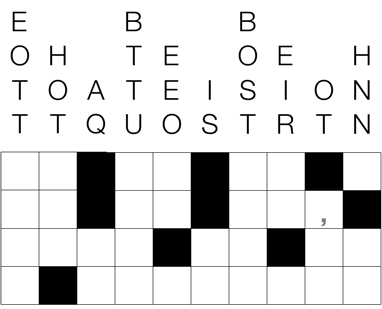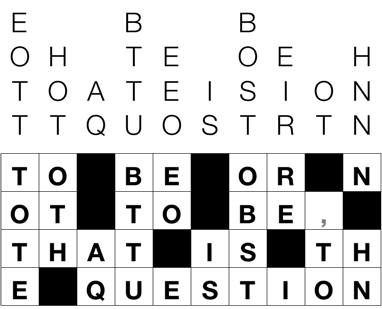 |
|
|
|
|
 How To Solve Puzzles
How To Solve Puzzles
How to Solve Drop Quote Puzzles
by Roy Leban
A drop quote puzzle consists of two parts — a grid of squares and a set of given letters which “drop” into the grid. When the puzzle is solved, the grid will be filled in with a quotation or other statement. Within the grid, blocks represent the spaces between words, and punctuation, if present, will already be placed. Each line in the grid is filled completely, so a word may be broken between lines, starting at the end of one line and continuing to the beginning of the next line — words only end at blocks or the end of the puzzle. The given letters at the top of a drop quote puzzle are organized by the column they “drop” into, and are given in alphabetical order. Use your knowledge of the language and process of elimination to figure out where each letter goes.
As you fill letters into the grid, tap on the letters above the grid to mark them off. If you realize you’ve marked off a letter by mistake, tap on it again to remove the mark.
In the sample puzzle below, see if you can figure out the answer before reading on for solving techniques. (The answer is shown at the bottom.)

Short Words
Isolated boxes are usually, but not always, the words A or I. Similarly, there are about 100 2-letter words, and only about 25 of them are common. When you have a 2-letter word, see what words you can make and then see what letters that leaves you over with for other lines. The most common 2-letter words are: OF, TO, IN, IT, IS, BE, AS, AT, SO, WE, HE, BY, OR, ON, DO, IF, ME, MY, UP, AN, GO, NO, US, AM.
While there are far more 3-letter words, think about the most common ones, which are: THE, AND, FOR, ARE, BUT, NOT, YOU, ALL, ANY, CAN, HAD, HER, WAS, ONE, OUR, OUT, DAY, GET, HAS, HIM, HIS, HOW, MAN, NEW, NOW, OLD, SEE, TWO, WAY, WHO, BOY, DID, ITS, LET, PUT, SAY, SHE, TOO, USE.
Contractions
Apostrophes indicating contractions can be a big help, because there are only a few letter combinations that follow an apostrophe. The two most common letters after an apostrophe are S and T.
- ’S words include HE’S, IT’S, LET’S, SHE’S or anything used in the possessive sense
- N’T words include AREN’T, CAN’T, DIDN’T, DON’T, ISN’T, HASN’T, HADN’T, HAVEN’T, WEREN’T, WON’T
- ’D words include HE’D, I’D, SHE’D, THEY’D, WE’D
- ’LL words include HE’LL, I’LL, I’LL, SHE’LL, THEY’LL
- ’RE words include THEY’RE and YOU’RE
- ’VE words include I’VE, THEY’VE and YOU’VE
- ’M words include I’M
- An initial apostrophe is a word that has had initial letters dropped, as in ’EM
- A final apostrophe is most likely a plural possessive (usually ending in S) or a word that has had a G dropped, as in SINGIN’
Columns with Fewer Letters
Sometimes, the letters in a column with fewer letters can be placed quickly by noticing which letters must be consonants and vowels, or by eliminating the possibility of a letter appearing in a certain spot.
Uncommon Letters and Common Letter Pairs
If you have an uncommon letter such as a J, K, Q, X, or Z, think about what letters might go before or after it. Similarly, look for common consonant pairs such as TH, ND, NT, ST, as well as doubled letters.
Common Prefixes and Suffixes
Be alert for common prefixes such as DE-, MIS-, RE-, and UN-, as well as common suffixes such as -ABLE, -ED, -ING, -LY, -NESS, and -TION.
Iterate
Every time you fill in a letter, it means that you’ve eliminated some letters that can go elsewhere. Frequently, this means that you can immediately fill in some additional letters.
Hints
If all else fails, don’t forget you can get hints by tapping on the  icon and revealing a letter in the grid.
It’s not cheating to ask for a hint — the goal is to
have fun, so if asking for a hint increases your enjoyment, feel free.
icon and revealing a letter in the grid.
It’s not cheating to ask for a hint — the goal is to
have fun, so if asking for a hint increases your enjoyment, feel free.
Here is the answer to the sample puzzle above:




|
Our Puzzle Books Buy Gift Certificates
Our World-Class Authors
How to Solve Puzzles
Our exclusive, award-winning TouchWrite™ handwriting recognition
Special features: Puzzles Live 2013 100th Anniversary of the Crossword
Get the puzzle of the day:
Read the latest Puzzazz Newsletter
About Us Contact Us Support FAQ Read the Buzz about Puzzazz
Your account Redeem a coupon or special offer
Cookies: If you sign in, we use a cookie for that purpose. We also use cookies to manage your browser session.
If you use third-party services, such as Facebook, with Puzzazz, they may use cookies following their own policies.
© 2025 Puzzazz Privacy Policy



